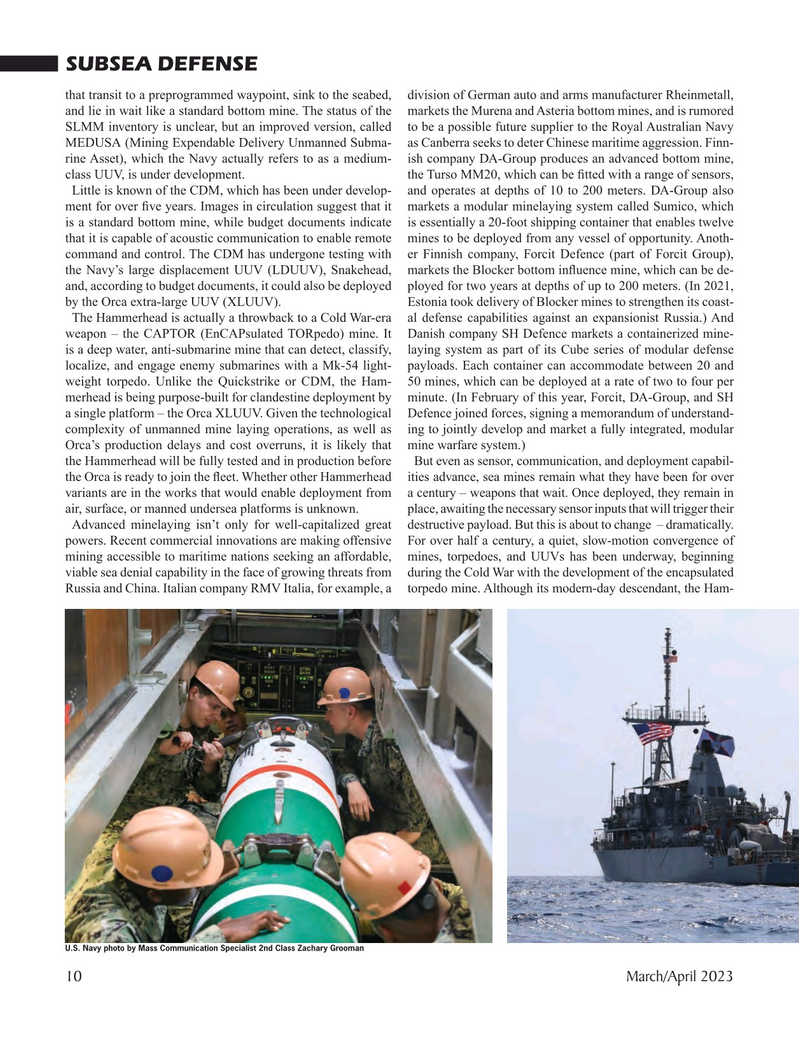
Page 10: of Marine Technology Magazine (March 2023)
Read this page in Pdf, Flash or Html5 edition of March 2023 Marine Technology Magazine
SUBSEA DEFENSE that transit to a preprogrammed waypoint, sink to the seabed, division of German auto and arms manufacturer Rheinmetall, and lie in wait like a standard bottom mine. The status of the markets the Murena and Asteria bottom mines, and is rumored
SLMM inventory is unclear, but an improved version, called to be a possible future supplier to the Royal Australian Navy
MEDUSA (Mining Expendable Delivery Unmanned Subma- as Canberra seeks to deter Chinese maritime aggression. Finn- rine Asset), which the Navy actually refers to as a medium- ish company DA-Group produces an advanced bottom mine, class UUV, is under development. the Turso MM20, which can be ? tted with a range of sensors,
Little is known of the CDM, which has been under develop- and operates at depths of 10 to 200 meters. DA-Group also ment for over ? ve years. Images in circulation suggest that it markets a modular minelaying system called Sumico, which is a standard bottom mine, while budget documents indicate is essentially a 20-foot shipping container that enables twelve that it is capable of acoustic communication to enable remote mines to be deployed from any vessel of opportunity. Anoth- command and control. The CDM has undergone testing with er Finnish company, Forcit Defence (part of Forcit Group), the Navy’s large displacement UUV (LDUUV), Snakehead, markets the Blocker bottom in? uence mine, which can be de- and, according to budget documents, it could also be deployed ployed for two years at depths of up to 200 meters. (In 2021, by the Orca extra-large UUV (XLUUV). Estonia took delivery of Blocker mines to strengthen its coast-
The Hammerhead is actually a throwback to a Cold War-era al defense capabilities against an expansionist Russia.) And weapon – the CAPTOR (EnCAPsulated TORpedo) mine. It Danish company SH Defence markets a containerized mine- is a deep water, anti-submarine mine that can detect, classify, laying system as part of its Cube series of modular defense localize, and engage enemy submarines with a Mk-54 light- payloads. Each container can accommodate between 20 and weight torpedo. Unlike the Quickstrike or CDM, the Ham- 50 mines, which can be deployed at a rate of two to four per merhead is being purpose-built for clandestine deployment by minute. (In February of this year, Forcit, DA-Group, and SH a single platform – the Orca XLUUV. Given the technological Defence joined forces, signing a memorandum of understand- complexity of unmanned mine laying operations, as well as ing to jointly develop and market a fully integrated, modular
Orca’s production delays and cost overruns, it is likely that mine warfare system.) the Hammerhead will be fully tested and in production before But even as sensor, communication, and deployment capabil- the Orca is ready to join the ? eet. Whether other Hammerhead ities advance, sea mines remain what they have been for over variants are in the works that would enable deployment from a century – weapons that wait. Once deployed, they remain in air, surface, or manned undersea platforms is unknown. place, awaiting the necessary sensor inputs that will trigger their
Advanced minelaying isn’t only for well-capitalized great destructive payload. But this is about to change – dramatically. powers. Recent commercial innovations are making offensive For over half a century, a quiet, slow-motion convergence of mining accessible to maritime nations seeking an affordable, mines, torpedoes, and UUVs has been underway, beginning viable sea denial capability in the face of growing threats from during the Cold War with the development of the encapsulated
Russia and China. Italian company RMV Italia, for example, a torpedo mine. Although its modern-day descendant, the Ham-
U.S. Navy photo by Mass Communication Specialist 2nd Class Zachary Grooman 10 March/April 2023
MTR #3 (1-17).indd 10 3/17/2023 4:41:16 PM

 9
9

 11
11
